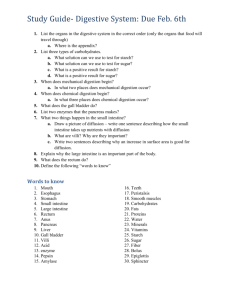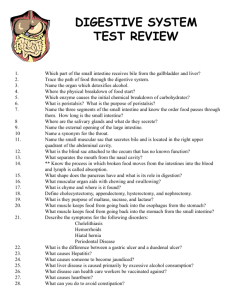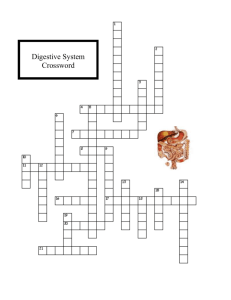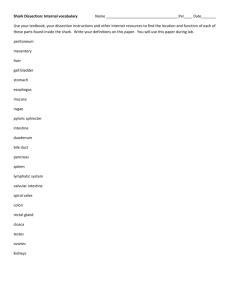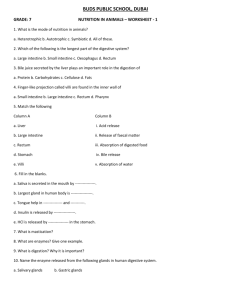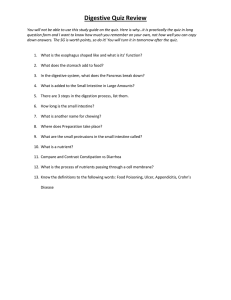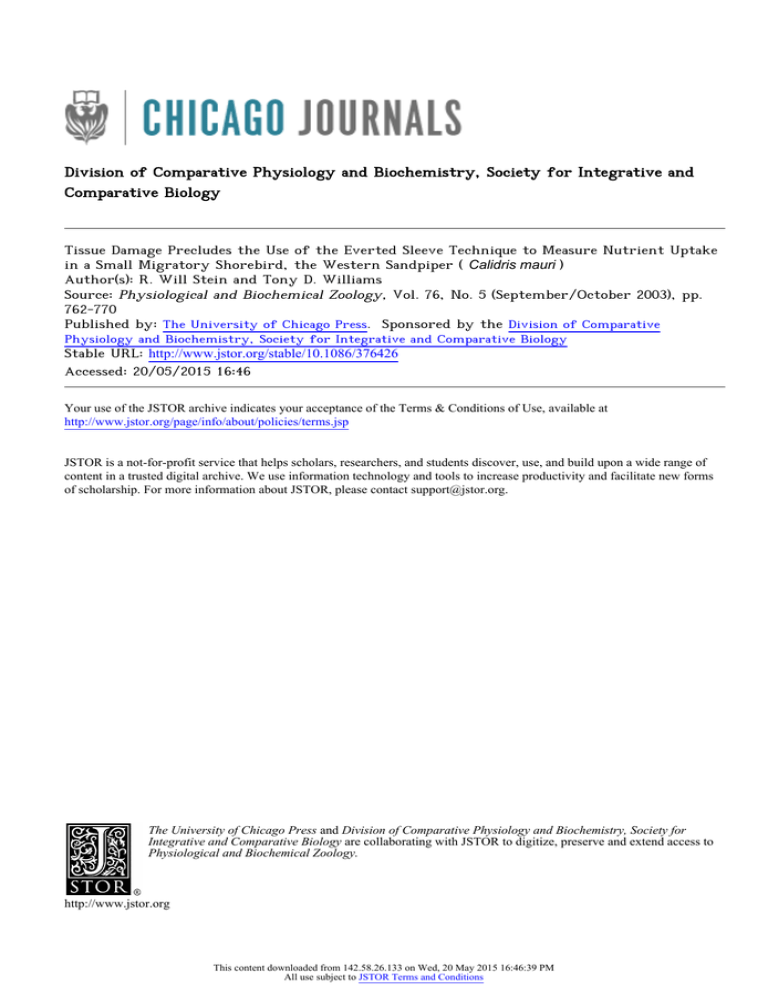
Division of Comparative Physiology and Biochemistry, Society for Integrative and
Comparative Biology
Tissue Damage Precludes the Use of the Everted Sleeve Technique to Measure Nutrient Uptake
in a Small Migratory Shorebird, the Western Sandpiper ( Calidris mauri )
Author(s): R. Will Stein and Tony D. Williams
Source: Physiological and Biochemical Zoology, Vol. 76, No. 5 (September/October 2003), pp.
762-770
Published by: The University of Chicago Press. Sponsored by the Division of Comparative
Physiology and Biochemistry, Society for Integrative and Comparative Biology
Stable URL: http://www.jstor.org/stable/10.1086/376426 .
Accessed: 20/05/2015 16:46
Your use of the JSTOR archive indicates your acceptance of the Terms & Conditions of Use, available at .
http://www.jstor.org/page/info/about/policies/terms.jsp
.
JSTOR is a not-for-profit service that helps scholars, researchers, and students discover, use, and build upon a wide range of
content in a trusted digital archive. We use information technology and tools to increase productivity and facilitate new forms
of scholarship. For more information about JSTOR, please contact support@jstor.org.
.
The University of Chicago Press and Division of Comparative Physiology and Biochemistry, Society for
Integrative and Comparative Biology are collaborating with JSTOR to digitize, preserve and extend access to
Physiological and Biochemical Zoology.
http://www.jstor.org
This content downloaded from 142.58.26.133 on Wed, 20 May 2015 16:46:39 PM
All use subject to JSTOR Terms and Conditions
762
TECHNICAL COMMENT
Tissue Damage Precludes the Use of the Everted Sleeve Technique to
Measure Nutrient Uptake in a Small Migratory Shorebird, the
Western Sandpiper (Calidris mauri)
R. Will Stein*
Tony D. Williams
Centre for Wildlife Ecology, Department of Biological
Sciences, Simon Fraser University, Burnaby, British Columbia
V5A 1S6, Canada
Accepted 3/24/03
Introduction
In vitro measurement of nutrient (e.g., glucose and proline)
uptake rates across the brush border of the small intestine has
played an integral role in the current understanding of the
adaptive responses of the digestive system to artificial selection
for rapid growth in domestic poultry (Gallus gallus; Obst and
Diamond 1992; Jackson and Diamond 1996) and the energetic
demands of provisioning young (Dykstra and Karasov 1992;
Konarzewski and Diamond 1994; Hammond et al. 1996). In
1983, Karasov and Diamond introduced a simplified methodology for making in vitro measurements of nutrient uptake
across the brush border of the small intestine, called the everted
sleeve technique. Accurate assessment of modulation of mediated uptake with the everted sleeve technique requires measurement of (1) passive uptake and (2) the sum of passive and
mediated (combined) uptake across intact mucosal epithelium
with cytologically intact enterocytes (Starck et al. 2000). Recently, Starck et al. (2000) demonstrated that extensive tissue
damage may occur due to eversion and, subsequently, to stirring
during incubation with the everted sleeve technique. They recommended that histological evaluations of tissue damage be
conducted to assess the reliability of uptake measurements
when this technique is applied to a new species or life stage.
The majority of the studies that have examined changes in
digestive performance, that is, modulation of mediated nutrient
uptake rates, of small endotherms (mainly rodents and birds)
* Corresponding author; e-mail: rwstein@sfu.ca.
Physiological and Biochemical Zoology 76(5):762–770. 2003. 䉷 2003 by The
University of Chicago. All rights reserved. 1522-2152/2003/7605-2152$15.00
using the everted sleeve technique have done so with animals
maintained in captivity on a relatively long-term basis. In captivity, environmental variability can be controlled and treatments can be applied uniformly to experimental groups; this
circumstance offers an effective means of demonstrating causal
relationships and the limits of digestive performance (Dykstra
and Karasov 1992; Caveides-Vidal and Karasov 1996; Hammond et al. 1996; McWilliams et al. 1999; Kristan and Hammond 2000). However, for birds and mammals it may not be
possible to extrapolate accurately from results obtained from
captive individuals to those expected from free-living individuals (Starck et al. 2000). Captive conditions can result in
changes in the absolute size of digestive organs, which may be
the indirect result of a change in body composition, specifically
lean mass, due to changes in diet composition and activity
patterns associated with captivity (Brugger 1991).
This study was designed to examine the functional significance of an age-related difference in small intestine size in a
long-distance migrant shorebird, the western sandpiper (Calidris mauri). Guglielmo and Williams (2003) reported that during the first southward migration juvenile western sandpipers
have the heaviest small intestine, relative to body mass, of their
entire life. This age-related difference in small intestine size
reflects a difference in intestine length, which appears to be
related to growth, at least initially (Stein 2002, p. 114). We
attempted to validate the everted sleeve technique for use in
western sandpipers, both recently captured juvenile migrants
and long-term captive adults. In the fall of 1999, we conducted
experiments to validate the use of the everted sleeve technique
to measure nutrient uptake in vitro, as described in Karasov
and Diamond (1983), for this migratory shorebird. In 2000, it
came to our attention that a histological evaluation of tissue
integrity was necessary to ensure reliability of measurements
made with this technique (Starck et al. 2000). Therefore, in
2000 we conducted histological evaluations of tissue sections
before, during, and after the use of this assay to measure nutrient uptake for migrants and captives. Here, we assess the
reliability of mediated proline uptake measurements from recently captured migrants, describe changes in the morphometry
of the small intestine associated with acclimation to captivity,
and evaluate tissue damage associated with the everted sleeve
This content downloaded from 142.58.26.133 on Wed, 20 May 2015 16:46:39 PM
All use subject to JSTOR Terms and Conditions
Technical Comment 763
technique when it was applied to recently captured migrants
and long-term captives.
Material and Methods
During the fall of 1999 and the spring and fall of 2000, sandpipers were collected while refueling on migration at Boundary
Bay, British Columbia (49⬚10⬘N, 123⬚05⬘W), the first major
stopover site south of the breeding grounds. To minimize the
number of individuals collected, females were sampled exclusively. In 1999, seven adults (July 10–13) and 13 juveniles (August 8–27) were collected during fall migration for use in nutrient uptake experiments. In 2000, four adults (May 1–9) were
brought into captivity during spring migration and four juveniles (August 9–27) were collected during fall migration to
assess tissue damage associated with the everted sleeve technique. Sandpipers were captured with mist nets (1.25-inch
mesh, Avinet, Dryden, N.Y.) and collected in accordance with
permits from Environment Canada. Animal handling protocols
were approved by the Simon Fraser University Animal Care
Committee (permit 529B) and conformed to the Canadian
Committee for Animal Care Guidelines.
Immediately after capture, each bird was weighed (capture
mass, Ⳳ0.001 g) and culmen length was measured to determine
gender. By the time the juveniles arrive at Boundary Bay during
southward migration, that is, the beginning of August, they
have completed structural growth (Guglielmo and Williams
2003); therefore, birds with a culmen length greater than 24.8
mm were considered to be females (Page and Fearis 1974).
Birds were transported to Simon Fraser University within 2 h
of capture, where dissections were conducted in accordance
with nutrient uptake experiments. During the spring of 2000,
adult females were brought into captivity and maintained in a
large outdoor aviary. These birds were exposed to the natural
light cycle and were fed a diet of Clarke’s dry trout chow, which
was available ad lib. The birds were able to fly in the aviary
and had constant access to fresh running water. Captives were
maintained on this diet for 40 d before conducting experiments
to assess tissue damage.
Nutrient Uptake Measurements
Immediately before dissection, culmen and tarsus were measured with digital calipers (Ⳳ0.01 mm), and each bird was
weighed (dissection mass, Ⳳ0.001 g). Birds were killed with
an intramuscular injection (4.0 mL 25 g⫺1) of a 1 : 1 mixture
of ketamine hydrochloride (100 mg mL⫺1) and xylazine (20
mg mL⫺1), exsanguinated, and dissected immediately thereafter.
The small intestine was separated from the gizzard at the pylorus and from the large intestine immediately proximal to the
cecae. After removal, the small intestine was rinsed in ice-cold
avian Ringer’s (composition in mM: 50 mannitol, 136 NaCl,
4.7 KCl, 2.5 CaCl2, 1.2 KH2PO4, 1.2 MgSO4, and 20 NaHCO3
oxygenated with 95% O2 and 5% CO2; osmolality was 350
mOsm kg⫺1 H2O). The proximal end of the small intestine was
sutured to a gavauge needle, and its contents were gently purged
with ice-cold avian Ringer’s. Adherent fat and mesenteries were
removed, and the length of the small intestine was measured
using a modified version of the Brambell method (Freehling
and Moore 1987). The small intestine was suspended vertically
beside a ruler (Ⳳ0.5 mm) with the gavauge needle attached to
the proximal end. The weight of the gavauge needle (2.2 g)
straightened but did not stretch the small intestine. Subsequently, the small intestine was blotted dry and weighed
(Ⳳ0.001 g). At the end of each dissection the gender was verified, the keel was measured with digital calipers (Ⳳ0.01 mm),
and the carcass was stored at ⫺20⬚C.
We measured passive and combined (i.e., mediated plus passive) uptake of L-[14C(U)] proline (Amersham) across the brush
border membrane of everted sections of small intestine in vitro,
as described by Karasov and Diamond (1983). The small intestine was everted so that the mucosa faced outward. A
mucous-like material was extruded from the small intestine
during this procedure. Next, 1-cm sleeves of everted small intestine were preincubated at 40⬚C in avian Ringer’s for 5 min.
Incubation proceeded for 2 min in a proline solution that was
stirring at 1,200 rpm. To allow for correction of unabsorbed
L-proline in adherent fluid, the incubation solution also contained tracer concentrations of a membrane impermeable
marker, inulin ([3H] inulin, Amersham). In other avian species,
2 min has been sufficient to allow adherent preincubation solution to equilibrate with the labeled marker in the incubation
solution. In addition, uptake rates have remained linear during
this time period, ensuring measurement of unidirectional flux
of proline (Karasov and Levey 1990; Levey and Karasov 1992).
After incubation, tissues were blotted to remove adherent incubation solution, weighed, dissolved with tissue solubilizer
(TS-2, Research Products International), and counted in scintillation cocktail (Hionicflour, Packard) in a Beckman LS 6500
liquid scintillation spectrometer to obtain disintegrations per
minute. Counts for each isotope were corrected for quench and
for counts due to the other isotope appearing in each counting
channel.
To determine the optimal concentration of proline for incubation, it is necessary to determine the concentration of proline that saturates the amino acid transporters (Karasov and
Diamond 1983). To determine the proline concentration that
saturates the amino acid transporters for proline, intestinal
sleeves from 20 western sandpipers were incubated in solutions
(350 mOsm) containing 1, 5, 10, 25, and 50 mM L-proline
and a trace amount of L-[14C(U)] proline. Mediated L-proline
uptake is Na⫹ dependent. Therefore, to measure passive uptake
of L-proline, Na⫹ must be excluded from the incubation solution; this was accomplished by isosmotic replacement of Na⫹
with choline. Sleeves were prepared from the entire length of
the small intestine, except for the first and last 2 cm. After
This content downloaded from 142.58.26.133 on Wed, 20 May 2015 16:46:39 PM
All use subject to JSTOR Terms and Conditions
764 R. W. Stein and T. D. Williams
correcting for unabsorbed L-proline, passive and combined uptake values were normalized to intestinal sleeve mass (pmol
mg⫺1 min⫺1) and were expressed relative to absolute combined
uptake at 50 mM in the same intestinal region of the same
individual. Using relative uptake minimizes the effect of positional and interindividual variation (Karasov and Diamond
1983). The apparent passive permeability coefficient of Lproline was determined by simple linear regression of relative
passive uptake on L-proline concentration:
Relative passive uptake p (A # [P]).
The apparent passive permeability coefficient of proline is estimated by A, while [P] is the proline concentration (mmol)
of the incubation solution. The analysis of relative combined
uptake provides a second estimate of the apparent passive permeability coefficient of L-proline. The apparent carrier-mediated components of relative L-proline uptake were determined
by nonlinear regression of relative combined uptake on Lproline concentration. The model for relative combined uptake
incorporates passive and mediated (one carrier) uptake:
Relative combined uptake p
(A # [P]) ⫹ [(Jmax # [P]) # (K m # [P])⫺1].
The apparent maximal mediated uptake rate was estimated by
Jmax. The apparent Michaelis constant, that is, the proline concentration at which uptake is 0.5# apparent Jmax, was estimated
by Km, which is uncorrected for the effects of unstirred layers.
Digital images of individual cross sections were obtained at
four-power magnification with an Olympus Vanox microscope
connected to a computer. Images were analyzed with a PCbased image analysis software (Empix Imaging 2001). Before
analysis, digital images were converted to 8 bit gray scale, which
allows contrast manipulation. For each section, total crosssectional area, inner cross-sectional area (determined by the
distinction between the mucosa and smooth muscle [tunica
muscularis]), circumference, villus length (broken and intact
villi were measured separately), and villi number were measured. These measurements were made on digitized images of
eight to 10 cross sections from three to four tissue subsections
for each tissue section. The thickness of the smooth muscle
layer was not uniform. In order to determine the mean thickness of the muscle layer, the circular shape of the intestinal
cross sections was used to calculate the lengths of the radii of
circles with areas equal to the total cross sectional and inner
cross-sectional areas. The difference between these calculated
radii was reported as the mean muscle thickness. Lumen area
of intact cross sections and mucosal area of everted sections
were obtained by adjusting the contrast of the digital images
and then employing threshold analysis. Threshold analysis calculates the area within a defined polygon and partitions this
area based on pixel contrast. Subsequently, the percentages of
smooth muscle, mucosa, and lumen were calculated based on
cross-sectional area. To avoid pseudoreplication, statistical analyses were performed on the mean values for a single tissue
section.
Data Analysis
Histology and Morphometry
To obtain descriptive data on the internal morphology of the
small intestine, histological sections were prepared from the
proximal and distal duodenum, jejunum, and proximal and
distal ileum of recently captured juvenile migrants (n p 4 ) and
long-term captive adults (n p 4 ). To evaluate the effects of
tissue handling during nutrient uptake experiments, histological sections were prepared from the jejunum (1) before eversion, (2) after eversion but before incubation, and (3) after
eversion, preincubation for 5 min, and incubation for 2 min
in a proline solution that was being stirred at 1,200 rpm. As
before, a mucous-like material was extruded from the small
intestine during eversion. Tissue sections were fixed in 10%
formalin in 0.1 M phosphate-buffered saline, pH 7.4, for 48–
72 h at room temperature. Fixed tissue sections were divided
into subsections with a razor blade. Tissue subsections were
dehydrated in 70% ethanol and 30% xylene, followed by 100%
xylene, and then embedded in paraffin. Cross sections of the
tissue subsections were cut at 5 mm on a rotary paraffin microtome, mounted onto microscope slides, and stained with
hematoxylin and eosin.
As a measure of structural body size, we used the first component (PC1) from a single principal components analysis
(PCA) of culmen, tarsus, and keel length (Rising and Somers
1989) performed on all of the birds included in this study. PC1
explained 57% of the variation in the univariate measures of
structural body size, which all had large positive loadings
(culmen p 0.60, tarsus p 0.64, and keel p 0.49) on PC1
(eigenvalue p 1.71). Within each age class, the two sample ttest was used to detect annual differences in body size (univariate: culmen, tarsus, and keel; multivariate: PC1) and body
mass (capture and dissection). ANCOVA was used to examine
the influence of year and acclimation to captivity on small
intestine length and mass. The time that elapsed between capture and dissection was used as a covariate in the analysis of
intestine length, because intestine length is known to increase
after feeding (Robel et al. 1990); it is expected to contract while
fasting. Small intestine length was used as a covariate in analysis
of small intestine mass; this resulted in an analysis of lengthcorrected mass. Relationships between variables were examined
using linear and nonlinear regression. Repeated-measures
ANOVA was used to examine changes in body mass of captive
sandpipers, variation in morphometry along the length of the
This content downloaded from 142.58.26.133 on Wed, 20 May 2015 16:46:39 PM
All use subject to JSTOR Terms and Conditions
Technical Comment 765
Figure 1. Changes in the body mass of female western sandpipers
during acclimation to captivity (n p 4). Values are means Ⳳ SEM.
intestine, and damage due to tissue eversion and subsequent
incubation. Where possible, the significance of interactions was
examined. In univariate analyses, each dependent variable was
considered separately, and the overall experiment-wise error
rate was controlled by Bonferroni correction (a p 0.05). Statistical analyses were conducted in SAS (SAS Institute 1990).
The nonlinear regression component of Sigma Plot was used
to fit the kinetics model to the combined uptake data (SPSS
Science 1999).
Results
Variation in Body Size, Body Mass, and Small Intestine Size
Annual variation in body size, body mass, and small intestine
size was examined separately for the two age classes. For juveniles, culmen, tarsus, and keel lengths were independent of
year (P 1 0.05 in all cases), as was structural size (PC1, t 15 p
1.33, P 1 0.2). At capture, juveniles caught in 1999 were 12%
heavier than those caught in 2000 (t 15 p 2.45, P ≤ 0.05). At
dissection, however, body mass was independent of year for
juveniles (t 15 p 1.44, P 1 0.17). Small intestine length was independent of year for juveniles (F1, 14 p 0.79, P 1 0.4), as was
the length-corrected mass of the small intestine (F1, 14 p 0.47,
P 1 0.5). Similarly, for the adults, culmen, tarsus, and keel
lengths were independent of year (P 1 0.05 in all cases), as was
structural size (PC1, t 9 p 0.36, P 1 0.7). At capture, body mass
was independent of year for adults (t 9 p 0.61, P 1 0.6). At dissection, however, long-term captive adults were 27% heavier
than recently captured adult migrants (t 9 p 4.61, P ≤ 0.001).
After adult migrants were brought into captivity in the spring
of 2000, their body mass increased 12%, reaching a plateau by
day 10 (F5, 15 p 22.55, P ≤ 0.001; Fig. 1). Small intestine length
did not vary between adult migrants and captives (F1, 8 p
0.23, P 1 0.7; Table 1); however, the length-corrected mass of
the small intestine mass was 22% lower in captive adults
(F1, 8 p 9.34, P ≤ 0.025).
Uptake Measurements
To determine the proline concentration that saturates the amino
acid transporters, which actively transport proline across the
brush border membrane, nutrient uptake experiments were conducted on 20 recently captured refueling female western sandpipers (n p 13 juveniles and n p 7 adults). If measurements are
made on intact tissue, then the proline concentration that saturates the available transporters should be apparent graphically
as a plateau in the expected hyperbolic relationship between
relative L-proline uptake and L-proline concentration. However,
we observed a near linear fit with the kinetics model for combined
uptake, and the relationship between combined uptake and proline concentration closely approximated the linear relationship
between passive uptake and proline concentration (Fig. 2). The
relative passive uptake model yielded an apparent passive per-
Table 1: Body mass and small intestine size of recently captured migrant and long-term captive female
western sandpipers (n p 28) used in uptake experiments and histological studies
Adults
Juveniles
1999
Migrants’ Uptake
Parameter
Capture mass (g)
Dissection mass (g)
Small intestine (cm)a
Small intestine (g)b
n
29.1
26.2
22.1
1.28
13
Ⳳ
Ⳳ
Ⳳ
Ⳳ
.8a
.7a
.4a
.06a
2000
Migrants’ Histology
25.4
24.4
23.1
1.18
4
Ⳳ
Ⳳ
Ⳳ
Ⳳ
.3b
.5a
.6a
.12a
1999
Migrants’ Uptake
25.8
23.4
20.7
.97
7
Ⳳ
Ⳳ
Ⳳ
Ⳳ
2000
Captives’ Histology
1.0a
1.0a
.5a
.04a
26.6
29.8
20.3
.76
4
Ⳳ
Ⳳ
Ⳳ
Ⳳ
.8a
.5b
.7a
.06b
Note. Comparisons were made within age classes, and values are means Ⳳ SEM. Different superscripts or subscripts indicate statistically
significant differences, P ! 0.05.
a
Least squares means, controlling for time to dissection.
b
Least squares means, controlling for small intestine length, that is, length-corrected mass.
This content downloaded from 142.58.26.133 on Wed, 20 May 2015 16:46:39 PM
All use subject to JSTOR Terms and Conditions
766 R. W. Stein and T. D. Williams
Therefore, the interaction term was removed from the model,
and this resulted in relative uptake p 0.02 # [P] (F1, 43 p
17.88, P ! 0.001, r 2 p 0.88). This result suggests either that passive proline uptake was predominant or that there was extensive
tissue damage.
Small Intestine Morphometry
Figure 2. Relative combined (mediated plus passive) and passive proline uptake in the small intestine of recently captured migrant western
sandpipers. Measurements were made in vitro, using the everted sleeve
technique. [P] is proline concentration.
meability coefficient of 0.02 pmol proline # mg tissue⫺1 #
proline concentration⫺1 (F1, 16 p 17.66, P ! 0.001, r 2 p 0.95),
while the relative combined uptake model yielded an apparent
passive permeability coefficient of 0.04 pmol proline # mg
tissue⫺1 # proline concentration⫺1. The relative combined uptake model also yielded estimates of the apparent Jmax p ⫺2.6
pmoles min⫺1 mg tissue⫺1 and apparent K m p 125 mM proline
(F2, 24 p 66.60, P ! 0.001, r 2 p 0.85). Due to the unexpected linear relationship between relative combined uptake and proline
concentration, a negative Jmax parameter estimate, and a very large
Km parameter estimate, we pooled the relative passive and relative
combined uptake data and fit the pooled data with the passive
uptake model, including an interaction term. In this analysis, the
interaction between relative uptake (passive vs. combined) and
proline concentration was not significant (F1, 41 p 0.41, P 1 0.5).
Variation in morphometry was examined along the length of
the small intestine in recently captured juvenile migrants and
long-term captive adult western sandpipers. Circumference decreased distally by 20% in migrants (F4, 12 p 9.36, P ≤ 0.001;
Table 2) and by 26% in captives (F4, 12 p 20.71, P ≤ 0.001; Table
3). Smooth muscle thickness increased distally by 130% in
migrants (F4, 12 p 15.76, P ≤ 0.001) and by 55% in captives
(F4, 12 p 6.50, P ≤ 0.01). Villus length decreased distally by 37%
in migrants (F4, 12 p 17.72, P ≤ 0.001) and by 36% in captives
(F4, 12 p 16.98, P ≤ 0.001). Villi number was independent of
intestinal subregion for migrants (F4, 12 p 1.52, P 1 0.15) and
captives (F4, 12 p 2.08, P 1 0.15). The percentage of the crosssectional area occupied by smooth muscle increased distally by
23% in migrants (F4, 12 p 33.10, P ≤ 0.001) and by 16% in captives (F4, 12 p 11.64, P ≤ 0.001). The percentage of the crosssectional area occupied by mucosa decreased distally by 27%
in migrants (F4, 12 p 21.60, P ≤ 0.001) and by 18% in captives
(F4, 12 p 18.96, P ≤ 0.001). The percentage of the cross-sectional
area occupied by lumen was independent of intestinal subregion
for migrants (F4, 12 p 4.35, P 1 0.02) and captives (F4, 12 p
0.38, P 1 0.8).
Histological Evaluation of Tissue Damage
The histology of noneverted sections of jejunum was similar
for recently captured migrants and long-term captives (Fig. 3A
and 3B, respectively). The inner mucosal membrane was
Table 2: Small intestine morphometry of recently captured juvenile female western sandpipers (n p 4)
Morphometric
Parameter
Linear measures:
Circumference (mm)
Muscle width (mm)
Villus length (mm)a
Villi number
Area percentages:
Muscle
Mucosa
Lumen
n
Proximal Duodenum
7.3
80
830
29
13
77
10
4
Ⳳ .4a
Ⳳ 7a
Ⳳ 60a
Ⳳ .4a
Ⳳ 1a
Ⳳ 1a
Ⳳ 1a
Distal Duodenum
Jejunum
7.0
105
815
29
Ⳳ .2a
Ⳳ 7ab
Ⳳ 42a
Ⳳ .4a
6.9
99
640
27
18
74
8
4
Ⳳ 1a
Ⳳ 2ab
Ⳳ 1a
17
63
20
4
Ⳳ .2a
Ⳳ 10a
Ⳳ 46ab
Ⳳ 1.2a
Ⳳ 2a
Ⳳ 4b
Ⳳ 3b
Proximal Ileum
Distal Ileum
5.7
138
543
27
Ⳳ .3b
Ⳳ 14b
Ⳳ 30b
Ⳳ .6a
5.8
184
519
27
Ⳳ .4b
Ⳳ 19b
Ⳳ 28b
Ⳳ 1.0a
28
58
14
4
Ⳳ 2b
Ⳳ 5bc
Ⳳ 4ab
36
50
14
4
Ⳳ 3b
Ⳳ 2c
Ⳳ 3ab
Note. Values are means Ⳳ SEM. Different superscripts indicate statistically significant differences, P ! 0.05.
a
Intact villus length.
This content downloaded from 142.58.26.133 on Wed, 20 May 2015 16:46:39 PM
All use subject to JSTOR Terms and Conditions
Technical Comment 767
Table 3: Small intestine morphometry of long-term captive adult female western sandpipers (n p 4)
Morphometric
Parameter
Linear measures:
Circumference (mm)
Muscle width (mm)
Villus length (mm)a
Villi number
Area percentages:
Muscle
Mucosa
Lumen
n
Proximal Duodenum
6.0
80
692
30
16
70
14
4
Ⳳ .2a
Ⳳ 2a
Ⳳ 51a
Ⳳ .9a
Ⳳ 1a
Ⳳ 1a
Ⳳ 1a
Distal Duodenum
5.9
81
656
30
17
66
17
4
Ⳳ .2a
Ⳳ 3a
Ⳳ 51a
Ⳳ 1.0a
Ⳳ 1a
Ⳳ 2a
Ⳳ 1a
Jejunum
5.0
90
521
29
22
62
16
4
Ⳳ .1b
Ⳳ 4ab
Ⳳ 59ab
Ⳳ .2a
Ⳳ 2b
Ⳳ 3b
Ⳳ 2a
Proximal Ileum
4.6
112
436
28
28
56
16
4
Ⳳ .2bc
Ⳳ 10b
Ⳳ 25b
Ⳳ .7a
Ⳳ 2c
Ⳳ 3b
Ⳳ 2a
Distal Ileum
4.4
124
441
31
Ⳳ .0c
Ⳳ 16ab
Ⳳ 15b
Ⳳ .5a
32
52
16
4
Ⳳ 4c
Ⳳ 3b
Ⳳ 3ab
Note. Values are means Ⳳ SEM. Different superscripts indicate statistically significant differences, P ! 0.05.
a
Intact villus length.
formed by long, delicate villi. The connective tissue core (lamina propria mucosae) of the villi was characterized by the presence of smooth muscle cells and small blood vessels. The mucosal epithelium (lamina epethelialis mucosae) was composed
primarily of enterocytes with few goblet cells (characterized by
large vesicles). Crypts of Lieberkhun opened at the base of the
villi. The muscular wall (tunica muscularis) was quite thick;
however, the lamina muscularis mucosae was not discernible
with light microscopy.
We measured mucosal area, mean villus length (weighted
average of intact and broken villi), and percentage of unbroken
villi in sequential tissue sections from the jejunum before eversion, after eversion, and after eversion and incubation in a
proline solution that was being stirred at 1,200 rpm. The normal
morphometery of the small intestine of recently captured juvenile migrant and long-term captive adult western sandpipers
predisposed them to tissue damage from the everted sleeve
technique. The distance between opposing villi, that is, the
lumen, in the jejunum was 25% and 20% of its diameter in
migrants and captives, respectively. This allowed little room
through which to evert the small intestine. Therefore, eversion
of the small intestine resulted in pronounced effects on the
Figure 3. Histological cross sections of the jejunum of western sandpipers demonstrating damage due to eversion and subsequent incubation
with the everted sleeve technique. A, C, and E are from recently captured juvenile migrants, while B, D, and F are from long-term captive
adults. A and B depict intact tissue sections; C and D depict everted tissue sections; and E and F depict everted and subsequently incubated
tissue sections.
This content downloaded from 142.58.26.133 on Wed, 20 May 2015 16:46:39 PM
All use subject to JSTOR Terms and Conditions
768 R. W. Stein and T. D. Williams
histology of jejunal sections of migrants and captives (Fig. 3C
and 3D, respectively). Many villi were missing or broken, and
remaining villi often appeared as distorted structural artifacts.
Following eversion, mucosal area decreased 67% in migrants
(F2, 3 p 200.32, P ≤ 0.001; Table 4) and 62% in captives
(F2, 3 p 93.47, P ≤ 0.01). Mean villus length decreased 44% in
migrants (F2, 3 p 23.11, P ≤ 0.01) and 51% in captives (F2, 3 p
80.94, P ≤ 0.01). The percentage of broken villi increased threefold in migrants (F2, 3 p 34.31, P ! 0.01) and in captives
(F2, 3 p 939, P ! 0.001). After eversion, the mucosal epithelium
was no longer intact, as the majority of the villi had sustained
extensive damage. Incubation of everted tissue sections in a
nutrient solution stirring at 1,200 rpm caused little additional
damage (Fig. 3E and 3F, respectively), because the damage due
to eversion was so extensive (Table 4).
Discussion
The results of this study are unambiguous. For western sandpipers, acclimation to captivity resulted in an increase in body
mass and a reduction in the length-corrected mass of the small
intestine. This decrease in small intestine mass was associated
with a reduction in circumference and villus length; however,
it was not due to a decrease in intestine length. There was
extensive damage to the mucosa of jejunal sections of recently
captured migrants and long-term captives due to everting the
small intestine and subsequently incubating sections of it in a
nutrient solution that was being stirred at 1,200 rpm, as required by the everted sleeve assay. In migrants, mucosal area
decreased by 67%, mean villus length by 44%, and the percentage of unbroken villi increased threefold. Similarly, in captives, mucosal area decreased by 62%, mean villus length by
51%, and the percentage of broken villi also increased threefold.
The majority of the damage occurred as a result of everting
the small intestine. Tissue damage resulted in unreliable measurements of combined and passive L-proline uptake in recently
captured migrants. Consequently, we were not successful in
validating the everted sleeve technique for use in the western
sandpiper.
Captivity Effects
Captive conditions may result in a decrease in the size of the
digestive organs due to concentrated diets and/or decreased
activity (Brugger 1991). Adult western sandpipers became obese
after 10 days in captivity on an energy-rich diet fed ad lib.
When these birds were dissected after 40 d in captivity, there
was no difference in the length of the small intestine relative
to recently captured adult migrants; however, the lengthcorrected mass of the small intestine was 22% lower in the
captive adults. This decrease in the length-corrected mass of
the small intestine was associated with a reduction in circumference and also in villus length. Brugger (1991) demonstrated
that captive red-winged blackbirds (Agelaius phoeniceus) fed
energy-rich diets showed reductions in small intestine length,
circumference, and villus length. Similarly, Piersma et al. (1993)
observed reductions in gizzard size in captive red knots (Calidris
canutus) that consumed soft energy-rich food. Therefore, acclimation to captivity can result in substantial changes in the
absolute size of the digestive organs. This is an important consideration when making inferences from results obtained on
captives to those expected from free-living individuals.
Tissue Damage and Uptake Measurements
Mediated uptake measurements produced by the everted sleeve
method have been reproduced reliably in some species. We
Table 4: Assessment of tissue damage to jejunal sections of the small intestine of
recently captured juvenile migrant (n p 4) and long-term captive adult (n p 4) female
western sandpipers due to the everted sleeve technique
Jejunal Sections
Recently captured juveniles:
Mucosal area (106 mm2)
Villus length (mm)a
Unbroken villi (%)
n
Long-term captive adults:
Mucosal area (106 mm2)
Villus length (mm)a
Unbroken villi (%)
n
Control
Everted
Everted and Incubated
2.4 Ⳳ .2a
569 Ⳳ 60a
74 Ⳳ 10a
4
1.0 Ⳳ .2b
367 Ⳳ 11b
18 Ⳳ 6b
4
.8 Ⳳ .1b
318 Ⳳ 11b
8 Ⳳ 3b
4
1.3 Ⳳ .1a
452 Ⳳ 60a
71 Ⳳ 7a
4
.7 Ⳳ .1b
288 Ⳳ 8b
12 Ⳳ 3b
4
.5 Ⳳ .1b
223 Ⳳ 17b
2 Ⳳ 1b
4
Note. Values are means Ⳳ SEM. Different superscripts indicate statistically significant differences, P ! 0.05.
a
Weighted mean of broken and unbroken villi.
This content downloaded from 142.58.26.133 on Wed, 20 May 2015 16:46:39 PM
All use subject to JSTOR Terms and Conditions
Technical Comment 769
attempted to validate the everted sleeve technique for use on
a small shorebird that was actively refueling during migration
and were unsuccessful. One essential condition for successful
application of the everted sleeve technique in either circumstance is that there must be little or, ideally, no tissue damage
due to eversion and incubation. However, we observed extensive damage to the villi of the jejunum in histological sections,
and this damage resulted in unreliable mediated proline uptake
measurements for this species. Starck et al. (2000) observed a
similar extent of tissue damage in the sunbird (Nectarinia osea),
which also resulted in unreliable uptake measurements. However, they demonstrated an absence of tissue damage due to
everting the small intestines of domestic chickens and mice
(Mus domesticus); therefore, they were successful in validating
the everted sleeve technique for use in those two species. The
villi of domestic chickens and mice appear to be relatively short
and stout compared to those of sunbirds and sandpipers; this
may be part of the reason that no tissue damage occurred in
the two domestic species.
Starck et al. (2000) demonstrated that the long and delicate
villi of sunbirds could not sustain the mechanical forces of tissue
eversion. Western sandpipers also have long and thin villi, and
they exhibited a pattern of damage similar to that in the sunbirds. However, there may be other aspects of intestinal morphometry that make particular species prone to damage during
eversion. For instance, lumen diameter, that is, the distance
between opposing villi, represents the “working room” through
which the small intestine must be everted. In the western sandpiper, the diameter of the jejunal lumen is small relative to its
outside diameter. In recently captured juvenile migrants, the
diameter of the jejunal lumen represents 33% of the outside
diameter of the jejunum, and in long-term captive adults it
represents only 23%. This amount of working room suggests
that in some cases severe damage is inevitable. Muscle thickness
is another aspect of intestinal morphometry that could make
some species prone to damage during eversion. A thick muscle
layer makes the initial stage of eversion difficult, and, when
this occurs, the intestine must be held steady to enable eversion.
This could cause damage to the distal end, where eversion
begins. Therefore, it is good practice not to use sleeves from
near the ends of the intestine. In addition, a thick muscle layer
becomes stiff in ice-cold avian Ringer’s; this makes the natural
curvature of the small intestine firm, which may lead to additional damage along the entire length of the small intestine
during eversion.
We reiterate the cautionary statements of Starck et al. (2000):
it is essential to conduct a histological evaluation to assess
reliability of the everted sleeve technique before using it on a
species or in a circumstance where such an evaluation has not
been conducted. Although acclimation to captivity can cause
marked changes in the size of the digestive tract, we observed
similar patterns of tissue damage in long-term captive adult
and recently captured juvenile sandpipers. We concur with
Starck et al. (2000) that long delicate villi predispose some
species to extensive damage during eversion and suggest that
there are other aspects of intestinal morphometry (lumen diameter and smooth muscle thickness) that make tissue damage
more likely. These factors should be considered in future studies
using the everted sleeve technique.
Acknowledgments
I would like to thank W. H. Karasov for advice and suggestions
and B. Darken for demonstrating the everted sleeve technique.
I would also like to thank J. M. Starck for encouragement and
suggestions about the histological evaluation of tissue damage.
In addition, I would like to thank W. Challenger, S. Nath, and
P. Yen for help in the lab and in the field and T. Lacourse for
helping to prepare the histology plate and for commenting on
previous drafts of the article. Funding for this research was
provided by NSERC Canada.
Literature Cited
Brugger K.E. 1991. Anatomical adaptation of the gut to diet
in red-winged blackbirds (Agelaius phoeniceus). Auk 108:
562–567.
Caveides-Vidal E. and W.H. Karasov. 1996. Glucose and amino
acid absorption in the house sparrow intestine and its dietary
modulation. Am J Physiol 271:R561–R568.
Dykstra C.R. and W.H. Karasov. 1992. Changes in gut structure
and function of house wrens (Troglodytes aedon) in response
to increased energy demands. Physiol Zool 65:422–442.
Empix Imaging. 2001. Northern eclipse 6.0. Empix Imaging,
Mississauga, Ontario.
Freehling M.D. and J. Moore. 1987. A comparison of two techniques for measuring intestinal length. J Wildl Manage 51:
108–111.
Guglielmo C.G. and T.D. Williams. 2003. Phenotypic flexibility
of body composition in relation to migratory state, age, and
sex in the western sandpiper (Calidris mauri). Physiol
Biochem Zool 76:84–98.
Hammond K.A., K.C. Kent Lloyd, and J. Diamond. 1996. Is
mammary output capacity limiting to lactational performance in mice? J Exp Biol 199:337–349.
Jackson S. and J. Diamond. 1996. Metabolic and digestive responses to artificial selection in chickens. Evolution 50:1638–
1650.
Karasov W.H. and J. Diamond. 1983. A simple method for
measuring intestinal solute uptake in vitro. J Comp Physiol
152:105–116.
Karasov W.H. and D.J. Levey. 1990. Digestive system trade-offs
and adaptations of frugivorous passerine birds. Physiol Zool
63:1248–1270.
Konarzewski M. and J. Diamond. 1994. Peak sustained meta-
This content downloaded from 142.58.26.133 on Wed, 20 May 2015 16:46:39 PM
All use subject to JSTOR Terms and Conditions
770 R. W. Stein and T. D. Williams
bolic rate and its individual variation in cold-stressed mice.
Physiol Zool 67:1186–1212.
Kristan D.M. and K.A. Hammond. 2000. Combined effects of
cold exposure and sub-lethal intestinal parasites on host
morphology and physiology. J Exp Biol 203:3495–3504.
Levey D.J. and W.H. Karasov. 1992. Digestive modulation in a
seasonal frugivore, the american robin (Turdus migratorius).
Am J Physiol 262:G711–G718.
McWilliams S.R., E. Caviedes-Vidal, and W.H. Karasov, 1999.
Digestive adjustments in cedar waxwings to high feeding
rates. J Exp Zool 283:394–407.
Obst B.S. and J. Diamond. 1992. Ontogenesis of intestinal nutrient transport in domestic chickens (Gallus gallus) and its
relation to growth. Auk 109:451–464.
Page G. and B. Fearis. 1974. Sexing western sandpipers by bill
length. Bird-Banding 42:297–298.
Piersma T., A. Koolhaas, and A. Dekinga. 1993. Interactions
between stomach structure and diet choice in shorebirds.
Auk 110:552–564.
Rising J.D. and K.M. Somers. 1989. The measurement of overall
body size in birds. Auk 106:666–674.
Robel R.R., M.E. Barnes, K.E. Kemp, and J.L. Zimmerman.
1990. Influences of time postmortem, feeding activity, and
diet on digestive organ morphology of two emberezids. Auk
107:669–677.
SAS Institute. 1990. SAS/STAT User’s Guide. Release 6.03. SAS
Institute, Cary, N.C.
SPSS Science. 1999. SigmaPlot 5.05. SPSS Science, Chicago.
Starck J.M., W.H. Karasov, and D. Afik. 2000. Intestinal nutrient
uptake measurements and tissue damage: validating the
everted sleeves method. Physiol Biochem Zool 73:454–460.
Stein R.W. 2002. Busting a gut: age-related variation and seasonal modulation of digestive tract structure and function
in the western sandpiper. MS thesis. Simon Fraser University,
Burnaby, British Columbia.
This content downloaded from 142.58.26.133 on Wed, 20 May 2015 16:46:39 PM
All use subject to JSTOR Terms and Conditions


